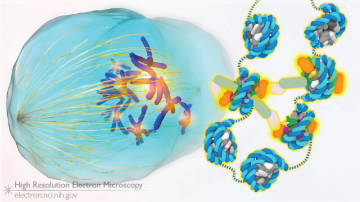The eukaryotic genome is structurally coordinated by histones, small disc-like protein complexes that are each wrapped twice by the DNA double helix. In addition to helping pack the long strands of DNA, histones have a variety of functions that regulate the use of the genome to express proteins. These histone-DNA complexes are called nucleosomes.
When the cell divides, the chromosomes condense into tightly packed chromatids, and special nucleosomes at one region of the chromosome (the centromere) bind to the kinetochore, a structure that aligns the chromatids properly so that they can separate to the two daughter cells. The difference between standard nucleosomes and kinetochore-binding nucleosomes is a particular type of histone subunit, called CENP-A, that replaces the H3 subunit of the standard nucleosome. The CENP-A subunit facilitates binding of several different proteins, such as CENP-N and CENP-C, which in turn attach the DNA-wrapped histone to the rest of the kinetochore.
In a collaboration between our lab, and that of Drs. Yawen Bai and Alexander Kelly, also at CCR, we used a combination of cryo-EM, biochemistry, and cell biology to derive new insights into the mechanism behind recognition of the CENP-A containing nucleosome by the kinetochore protein CENP-N. CENP-N binds to the edge of the histone just next to the wrapped DNA, recognizing a series of amino acids within one loop on CENP-A, while also interacting with the backbone of the wrapped DNA. Because multiple copies of these kinetochore proteins (like CENP-N) can bind at the same time, this could allow a chain-like clustering and organization of nucleosomes at the centromere to facilitate cell division. This study was published online in Science on December 21, 2017.
The image above shows the chromosomes (in dark blue, left) separating during cell division; the centromere is highlighted on the chromosomes. The CENP-A nucleosome (on the right) is shown bound to the kinetochore protein CENP-N (in orange) or other kinetochore-associated proteins (CENP-L in light pink and CENP-C in green).
Full-size image: Download (0.8MB)
Related Reference: Chittori S, Hong J, Saunders H, Feng H, Chirlando R, Kelly AE, Bai Y, and Subramaniam S. Structural mechanisms of centromeric nucleosome recognition by the kinetochore protein CENP-N. 2017 Dec 21. pii: eaar2781. doi: 10.1126/science.aar2781. [Pubmed]
